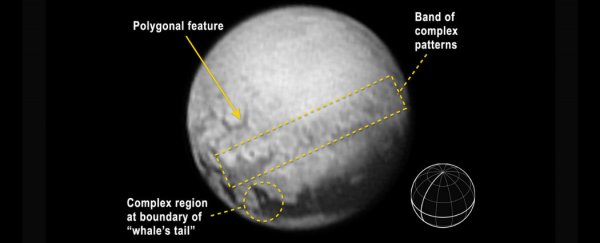New images of Pluto taken on July 9 by NASA's New Horizons spacecraft from a distance of 5.4 million km (3.3 million miles) have revealed the unique features that make up its strange, shadowy surface, including a feature that's been nicknamed 'the whale', and a dark, heart-shaped patch.
Now, more than 4.88 billion kilometres from Earth, New Horizons is about to make its closest flyby of Pluto and its five known moons, and will capture even better images of its icy exterior. It's set to fly past the dwarf planet at just 12,472 km (7,750 miles) from its surface at 11.49 GMT on Tuesday 14 July, and data captured during this time will be transmitted back to Earth over the next 16 months.
"We're close enough now that we're just starting to see Pluto's geology," New Horizons program scientist, Curt Niebur, said in a press release. Speaking about the whale's 'tail' in particular, which is part of a huge dark region that runs along 3,000 km (1,860 miles) of the defunct planet's equator, he added, "It's a unique transition region with a lot of dynamic processes interacting, which makes it of particular scientific interest."
The closer New Horizons gets, the more clearly Neibur and his team have been able to make out the shapes of the several light and dark spots that mark its surface, including bright doughnut and heart shapes.
The team suspects that the distinct beige colour made out by the craft's onboard Long-Range Reconnaissance Imager (LORRI) and Ralph imaging instrument are the result of large regions of frozen methane, nitrogen, and carbon monoxide in the dwarf planet's atmosphere.
"Among the structures tentatively identified in this new image are what appear to be polygonal features," New Horizons principal investigator, Alan Stern, said. "A complex band of terrain stretching east-northeast across the planet, approximately 1,000 miles [1,600 km] long; and a complex region where bright terrains meet the dark terrains of the whale. After nine and a half years in flight, Pluto is well worth the wait."
The New Horizons website outlines what's in store for the little spacecraft as it makes history this week:
"At 7:49 AM EDT on Tuesday July 14, the unmanned spacecraft will zip past Pluto at 30,800 miles/hour [49,600 km/h), with a suite of seven science instruments busily gathering data. The mission will complete the initial reconnaissance of the Solar System with the first-ever look at the icy dwarf planet."
You can follow the journey at NASA's New Horizons Facebook page, and we'll be posting images on our site as they come in. We can't wait to get to know our favourite dwarf planet even better.
